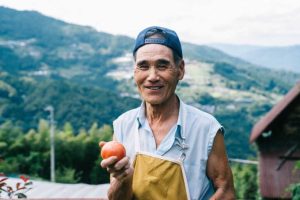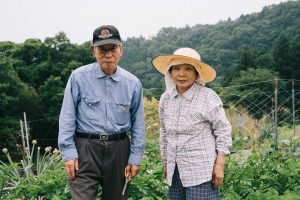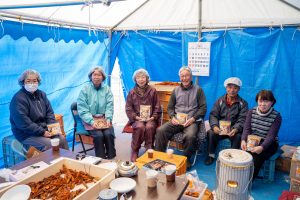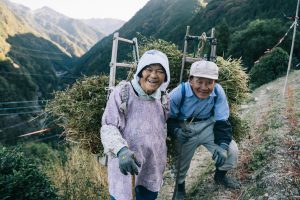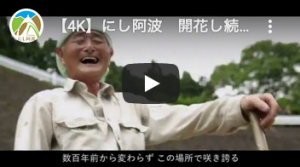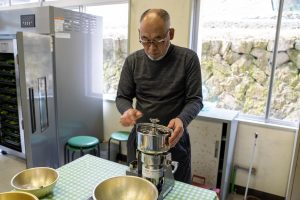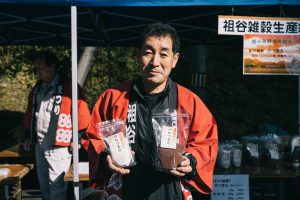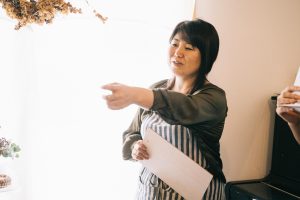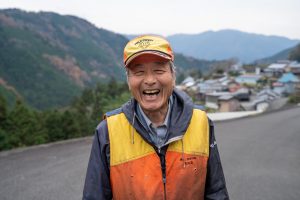Matsufumi Noda|The People Supporting Globally Important Agricultural Heritage System
Matsufumi Noda (Higashi-Miyoshi Town) Agricultural plastic greenhouses are arranged on mountain slopes in the villages of Higashi Miyoshi Town. Tomato cultivation has long been popular in the Nishisho district in the mountainous area of Higashi-Miyoshi town because the considerable difference in temperature makes it possible to produce tomatoes with a strong flavor. Mr. Matsufumi Noda grows large and small tomatoes in plastic greenhouses, and harvesting occurs in July. His tomatoes are shipped mainly within Tokushima Prefecture and to the Kansai region and are popular in local farmers’ markets for their sweetness and taste. He had been growing tomatoes for over 20 years but said, “I don’t know if I can […]
Shigetsugu Ikemoto and Yoshie Ikemoto|The People Supporting Globally Important Agricultural Heritage System
Shigetsugu Ikemoto and Yoshie Ikemoto (Wakimachi, Miyoshi City) The farmers’ market opens every Sunday and sells vegetables and processed products from the local Otani area. Mr. Shigetsugu Ikemoto is the head of the Farmers’ Market Management Council, and he cultivates vegetables for sale in the market with his wife, Mrs. Yoshie. Mr. and Mrs. Ikemoto have grown tobacco leaves for approximately 30 years. Subsequently, they raised poultry and grew soba and vegetable seeds. Currently, they grow a variety of vegetables each season and sell them directly in the market. The market also has a soba noodle shop, where visitors can eat soba and udon noodles made by Mrs. Yoshie. The […]
HOICHI-no-Hoshi-Imo|The People Supporting Globally Important Agricultural Heritage System
HOICHI-no-Hoshi-Imo (Higashi Miyoshi Town) Hoichi village in Higashi Miyoshi town is located in the middle of the Asan Mountains on the northern bank of the Yoshino River. The specialty products produced in this small village by approximately a dozen residents create a lively atmosphere for the community. One of the specialty products is “HOICHI-no-Hoshi-Imo,” dried sweet potatoes produced using traditional methods. Mr. Kikuo Yamakawa, a representative of HOICHI-no-Hoshi-Imo LLC, is responsible for producing and selling these dried sweet potatoes.Mr. Yamakawa is from Shikokuchuo City in Ehime Prefecture and has worked at mass merchandise stores in Ehime and Tokushima for approximately 30 years. At one time, Mr. Takemasa Ueta, who produced […]
Shinji Taguchi|The People Supporting Globally Important Agricultural Heritage System
Shinji Taguchi (Higashi Miyoshi Town) Izumino village is located in a mountainous area with a view of the Higashi Miyoshi town plain field. Mr. Shinji Taguchi returned from another prefecture and started his farm.He worked for electrical and precision machinery-related companies in Ehime and Tochigi Prefectures. However, he decided to retire early and returned to his hometown, Higashi Miyoshi town, three years ago.As his family initially worked in the agricultural industry, he grew vegetables throughout the year in his family’s fields. He sells freshly picked vegetables at local markets and wholesales them to the “Mikamo Café” in Higashi Miyoshi Town.This café serves salads and pastas made of fresh vegetables harvested […]
Handa Dried Persimmon Division|The People Supporting Globally Important Agricultural Heritage System
Tsurugi Town Dried Persimmon Group (Tsurugi Town) Atago persimmons are widely cultivated in the mountainous areas of Handa in the town of Tsurugi. Farmers in the Hiraraishi district gather to produce dried Atago persimmons, which are sold at roadside stations and are gaining popularity. Sericulture was popular in Handa. However, the cultivation of Atago persimmons has increased instead of gradually declining. Today, 50–60 farmers cultivate Atago persimmons, and this region is one of the leading producers in Shikoku. Four farmers in the Hiraraishi district gathered to form the Tsurugi town-dried persimmon group. Dried persimmons were processed from December to the end of February after finishing the harvest. Every person brings their Atago […]
Haruki Nishiokada and Setsuko Nishiokada|The People Supporting Globally Important Agricultural Heritage System
Haruki Nishiokada and Setsuko Nishiokada (Tsurugi Town) Mr. and Mrs. Nishiokada's farm in Sadamitsu Sarukai in Tsurugi is a symbolic place for Nishi Awa's steep-slope farming. They grow kidney beans in summer and buckwheat in fall. It is also a famous tourist farm because of the beauty of the valley at the bottom of its steep slopes and the surrounding mountains. They value local agricultural culture as much as cultivation. That is the traditional event "Oinokosan."Oinokosan" is a traditional event held on the first day of the boar in October of the lunar calendar as a prayer for plentiful harvests and family safety. There has long been a tradition of […]
Yoshinobu Amata|The People Supporting Globally Important Agricultural Heritage System
Yoshinobu Amata (Koyadaira, Mima City) Koyadaira in Mima City, located at the foot of Mount Tsurugisan, is known as the yuzum-producing area. Mr. Yoshinobu Amata officially began yuzu cultivation in Koyadaira. When sericulture declined in 1963, he focused on cultivating Yuzu because it sold at a high price. At first, it was said that Koyadaira was unsuitable for yuzu cultivation; however, the cultivation was successful and spread throughout Koyadaira. In the middle of 1975, the price of Yuzu was sometimes as high as JPY 6,000–JPY 7,000 for a box of 12. However, prices began to fall, reaching approximately 60 yen per kilogram, when it was cheapest in 1985. Mr. Amata […]
Norouchi Vegetable Processing and Producing Association|The People Supporting Globally Important Agricultural Heritage System
Norouchi Vegetable Processing and Production Association (Ikeda Town in Miyoshi City) The Kaminoro district of Ikeda town in Miyoshi City is located in the mountains at an altitude of 400–500 m above sea level. The area was originally a prosperous agricultural area where leaf tobacco was cultivated, and tomatoes and other summer vegetables are now grown in the area. In the Kaminoro district, 22 farm households have formed a vegetable processing and production association called " Aikurushii Yum-Yum" to revitalize an area that is losing vitality due to depopulation, aging of the population, and increasing abandonment of cultivated land. The product is a powder made from dried vegetables that cannot […]
Iya Millet Products Association|The People Supporting Globally Important Agricultural Heritage System
Iya Millet Products Association (Higashi-Iya in Miyoshi City) The Iya region of Miyoshi city is among the three unexplored regions of Japan. In this region, indigenous millets have been cultivated with buckwheat and other crops. One of the most valuable indigenous millets cultivated in this region is "Yatsumata (Finger millet)." Yatsumata (Finger millet) belongs to the grass family and is native to Eastern Africa. In Japan, it was cultivated mainly in mountainous regions such as Shikoku. Nowadays, it is popular as a superfood owing to its high nutritional value. People in Higashi-Iya have made considerable efforts to preserve Yatsumata. A man, who was the only producer of Yatsumata in Higashi-Iya, […]
Masumi Yoshida|The People Supporting Globally Important Agricultural Heritage System
Masumi Yoshida (Anabuki Town in Mima City / Ni to Ha・ruche CAHOA) The popular café ruche, CAHOA, is located in Anabuki Town, Mima City. Mrs. Masumi Yoshida owns this café, and her teenagers are popular among customers locally and from other prefectures. In 2019, she launched a project that covered everything from tea cultivation to commercialization because she wanted to pass on local tea, which has long been cultivated extensively in mountainous areas, to the next generation. She organized a "Ni to Ha" group with about ten local people in their 30s and 40s who agreed to participate in the project. They borrow a tea farm from Mr. Yasuo Koizumi, […]
Masao Kinoshita|The People Supporting Globally Important Agricultural Heritage System
Masao Kinoshita ( Higashi Miyoshi Town, Guest House, Uribou ) Mr Kinoshita has been an office worker for nearly 40 years. He has been managing guesthouses for approximately six years. It has become so famous that nearly 500 people visit annually for overnight stays, tours, and agricultural experiences. Mr. Kinoshita's daily routine appears busy. For example, "In winter, I patrol wild boar traps, check mountain roads, work in fields, and maintain farm equipment. I spend more time farming because of the longer daylight hours in summer. No time to rest when I welcome guests because I need to prepare for their dinner." However, he seemed happy to enjoy living there. He said, […]

